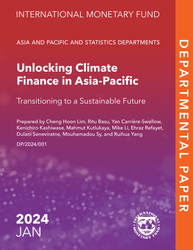
Unlocking Climate Finance in Asia-Pacific: Transitioning to a Sustainable Future
This paper provides an overview of the climate finance ecosystem in countries in the Asia-Pacific region and presents strategies to mobilize climate finance for the region’s transition to a sustainable future.
READ MORE...
Volume/Issue:
Volume 2024
Issue 001
Publication date: January 2024
ISBN: 9798400256752
$20.00
Add to Cart by clicking price of the language and format you'd like to purchase
Available Languages and Formats
| English |
Topics covered in this book
This title contains information about the following subjects.
Click on a subject if you would like to see other titles with the same subjects.
International - Economics , Environmental Economics , Environmental Conservation and Protection , Public Policy , Public Policy- Environmental Policy , Climate finance , green bonds , data , information architecture , policy , IMF Climate , IMF Library , unlocking climate finance , Climate datum , Asia-Pacific country , Climate change , Greenhouse gas emissions , Climate policy , Asia and Pacific , Global , Pacific Islands
Summary
The transition to a sustainable future in the Asia-Pacific region has global economic significance. Despite driving global growth in recent years, the region's heavy coal reliance led to significant greenhouse gas emissions. Meeting climate mitigation and adaptation needs in emerging and developing Asia requires investment of at least $1.1 trillion annually. Actual investment falls short by about $800 billion. Asia-Pacific’s environmental performance has also hampered its ability to tap into private flows from the fast-growing ESG asset class, keeping the cost of issuing sustainable debt instruments relatively high compared to other regions. This paper provides an overview of the climate finance ecosystem in countries in the Asia-Pacific region and presents strategies to mobilize climate finance for the region’s transition to a sustainable future. The paper identifies challenges, including gaps in the climate information architecture, policy conflicts, global complexities, and emphasizes the need for coordinated action involving governments, central banks, financial supervisors, the IMF, and other multilateral institutions. In particular, • Governments need to establish a well-defined climate strategy with strong institutional oversight and coordination to strengthen the framework on data, taxonomies, and disclosures. Fossil fuel subsidies should be phased out and carbon pricing schemes expanded to create fiscal space for sustainable investments. Strengthening macroeconomic management is essential to attract private capital. • Financial supervisors and central banks should coordinate across jurisdictions to promote global, interoperable disclosure standards, enhance climate risk analysis and reporting, and incorporate climate-related financial risks into prudential frameworks. Developing climate labels for sustainable investment funds and shifting the focus of ESG scores to better capture sustainability and climate impact would foster trust in the evaluations. The IMF can drive climate action by integrating discussions in surveillance activities and strengthening data and statistics—including through capacity building and peer learning—to develop common standards around climate risk measurement and analysis. The Resilience and Sustainability Trust could contribute to reducing financing gaps through its catalytic and reform supporting functions, while multilateral development banks could scale up grant financing and concessional lending, and where appropriate adopt risk-mitigating mechanisms to expand lending capacity. Cooperation among multilateral institutions is essential to align efforts and resources to achieve a balanced allocation between mitigation and adaptation lending.
Copyright © 2010 - 2025
Powered by:
AIDC



